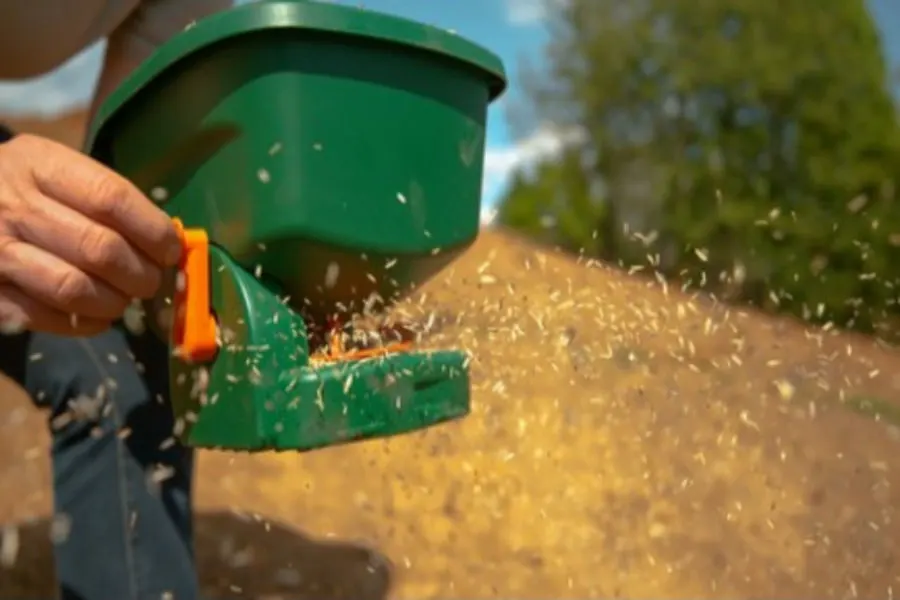Ad Blocker Detected
Our website is made possible by displaying online advertisements to our visitors. Please consider supporting us by disabling your ad blocker.
When it comes to planting grass seed and ensuring it grows successfully, there are two key strategies that can make all the difference between a struggling lawn and one that flourishes into a thick, lush green expanse.
Whether you’re filling in bare patches, seeding a large area, or establishing an entirely new lawn, getting grass seed to germinate and thrive can be a significant challenge for many homeowners.
It’s frustrating to spread a couple of bags of expensive grass seed only to see minimal results. Despite the rising cost of seed, planting grass is still the most cost-effective method for creating a beautiful lawn.

Laying down sod can be quite costly and demands constant care and watering to keep it alive. Other methods, like hydro-seeding, not only require specialized equipment but can also be 5 to 10 times more expensive than traditional seeding.
But here’s the good news: growing a healthy, dense lawn or filling in bare patches from seed doesn’t have to be complicated. The key lies in mastering the art of seeding. With just a few essential tips and tricks, you can achieve great results and save a significant amount of money in the process!
How To Plant Grass Seed – 2 Big Secrets To Get Grass To Grow Fast And Thick!
#1 Always Use Grass Seed Blends
One of the key secrets to successfully growing grass from seed is choosing not just high-quality seed, but the right type of seed.
When planting, it’s best to opt for a grass seed blend rather than a single variety. Blends contain a mix of different grass types that work together to create a thicker, more resilient lawn. Additionally, these blends are less susceptible to diseases, ensuring a healthier and more robust lawn.

A single variety of grass seed draws the same nutrients from the soil, which can lead to rapid depletion and struggling growth. Additionally, if a pest or disease targets that variety, it can wipe out the entire lawn.
In contrast, blends consist of different grass types with varying nutrient needs and resistance to diseases and pests. This diversity means that if one type is attacked, the others are likely to survive, ensuring the lawn remains healthy and resilient. Affiliate Grass Seed Link: Pennington Multi Use Tall Fescue Grass Seed Mix
Why Grass Seed Blends Are The Way To Go – How To Plant Grass Seed
#2 The Secret Of Adding Cover Crop Seed – How To Plant Grass Seed
Now, let’s move on to the second, and arguably most important, secret for successfully establishing new grass seed: always mix in a portion of annual cover crop seed when planting, regardless of the seed blend you choose.
This simple yet effective trick can significantly enhance germination rates, reduce the need for frequent watering, and help prevent weed seeds from taking root in your new lawn. The top two cover crop choices for this method are annual cereal rye and annual cereal oats. These grains have larger seeds and germinate quickly, providing a protective layer that supports your grass seed as it takes hold.
How Cover Crops Helps Grass Seed Grow Thick & Fast
Adding cover crop seed is crucial because it germinates quickly, creating a protective layer over the soil. This layer provides shade for your grass seed, helping it establish more effectively. Additionally, it covers bare soil, making it difficult for weed seeds to take root.
The cover crop acts like a living straw, retaining moisture and shielding your grass seed from the harsh summer sun. This not only helps your grass seed thrive but also reduces the need for constant watering, ensuring a healthier, more resilient lawn.

As your grass seed begins to establish, the cover crop continues to offer protection, sheltering the tender young grass as it grows. Over time, as you mow the cover crop a few times, it naturally dies off—allowing your lawn to fill in and thicken around it.
What’s more, as the roots and foliage of the cover crop decompose, they enrich the soil with nutrients, giving your lawn an extra boost to thrive. This combination is ideal for jump-starting your grass seed! For optimal results, mix in 1 pound of cover crop seed for every 3 to 4 pounds of grass seed. Just be sure to use an annual cover crop seed, not a perennial one. This type of seed is larger and distinct from traditional grass seed.
A Few Extra Tips & Tricks – How To Plant Grass Seed
Timing Your Planting

Growing new grass seed in the middle of summer can be particularly challenging. The combination of intense heat and dry conditions makes it difficult for seeds to establish. Constant watering is needed to help them germinate, but even then, the harsh sun can be too much for tender seedlings to handle.
The best times to plant grass seed are early spring and early fall. Both seasons typically offer cooler and wetter conditions, ideal for seed establishment. Among the two, early fall is generally superior. The cooler temperatures are easier on the young grass, and it avoids the stress of summer heat. Additionally, the grass can go dormant through the hot months and continue to establish during the cooler spring, leading to a more resilient and thriving lawn.

